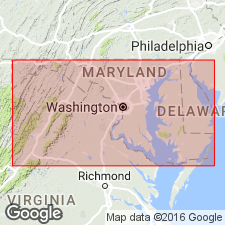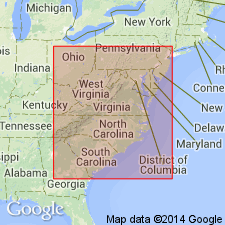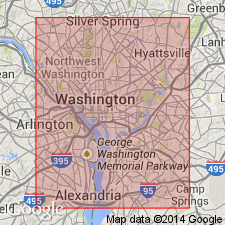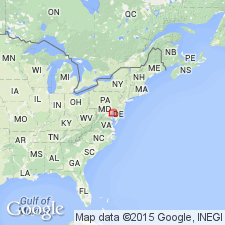
- Usage in publication:
-
- Patuxent formation
- Modifications:
-
- Named
- Dominant lithology:
-
- Sand
- Clay
- AAPG geologic province:
-
- Atlantic Coast basin
Summary:
Named the Patuxent formation of the Potomac group for the Little and Big Patuxent Rivers, MD. Consists of mainly sand that is sometimes quite pure and gritty, but generally contains considerable kaolinized feldspar, producing a clearly defined arkose. Clay lumps are scattered throughout. The sand beds frequently pass over gradually into sandy clays and eventually into argillaceous materials that are commonly light colored, but also often highly colored and variegated not unlike the Patapsco formation. The arenaceous beds are cross-bedded and gives evidence of shallow-water origin. Unit overlies crystalline rocks of the Piedmont province and unconformably underlies the Arundel formation of the Potomac group. The Patuxent is of Early Cretaceous age.
Source: GNU records (USGS DDS-6; Reston GNULEX).

- Usage in publication:
-
- Patuxent formation
- Modifications:
-
- Biostratigraphic dating
- AAPG geologic province:
-
- Atlantic Coast basin
Summary:
Flora from the Patuxent formation of the Potomac group compare with the Wealden flora of England and indicate that the Patuxent is of Early Cretaceous (Neocomian) age.
Source: GNU records (USGS DDS-6; Reston GNULEX).

- Usage in publication:
-
- Patuxent formation*
- Modifications:
-
- Areal extent
- AAPG geologic province:
-
- Atlantic Coast basin
Summary:
Geographically extended the Patuxent formation of the Potomac group to Washington, DC. Contains large amounts of sand commonly mixed with more or less kaolin and mica, gravel and lenses of various colored or white massive clay. Unit is basal formation of Coastal Plain and overlies crystalline basement rocks of the Piedmont province and unconformably underlies the Arundel clay of the Potomac group. The Patuxent is of Early Cretaceous age.
Source: GNU records (USGS DDS-6; Reston GNULEX).

- Usage in publication:
-
- Patuxent Formation
- Modifications:
-
- Biostratigraphic dating
- AAPG geologic province:
-
- Atlantic Coast basin
Summary:
The Patuxent Formation of the Potomac Group is composed of cross-bedded and lenticular sands and gravels with minor amounts of light gray, brown, and pink clay beds. Thickness in surface section ranges from 150 to 350 feet. Unit rests directly on crystalline basement rocks and unconformably underlies the Arundel Clay of the Potomac Group. Spore and pollen data indicate that the Patuxent is of Early Cretaceous (late Barremian) age and maybe slightly older.
Source: GNU records (USGS DDS-6; Reston GNULEX).
For more information, please contact Nancy Stamm, Geologic Names Committee Secretary.
Asterisk (*) indicates published by U.S. Geological Survey authors.
"No current usage" (†) implies that a name has been abandoned or has fallen into disuse. Former usage and, if known, replacement name given in parentheses ( ).
Slash (/) indicates name conflicts with nomenclatural guidelines (CSN, 1933; ACSN, 1961, 1970; NACSN, 1983, 2005, 2021). May be explained within brackets ([ ]).

